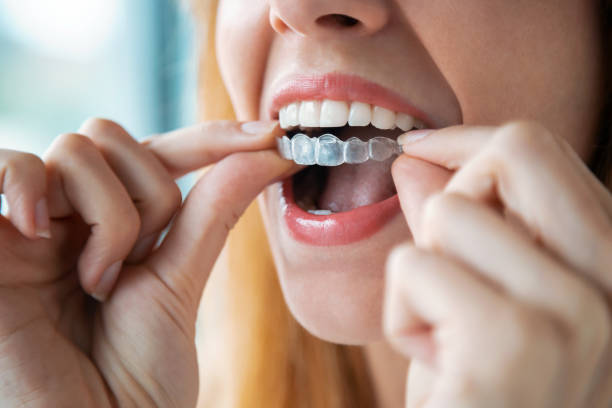Understanding Dental Aligners
Dental aligners, often referred to as clear aligners, are custom-made trays crafted from medical-grade plastic designed to fit snugly over the teeth. Unlike traditional metal braces, these aligners are virtually invisible and can be removed at will, offering an aesthetic and practical solution for those seeking orthodontic treatment.
Advantages of Dental Aligners
1. Aesthetic Appeal
-
Invisible Appearance: Clear aligners are practically invisible, making them a preferred choice for individuals concerned about the appearance of traditional metal braces.
-
Boost Confidence: Users can smile confidently during treatment without visible metal brackets.
2. Comfort and Convenience
-
No Metal Wires or Brackets: This reduces the chance of oral irritation and discomfort.
-
Removable: Aligners can be removed for eating, brushing, and special occasions, providing greater flexibility in daily life.
3. Improved Oral Hygiene
-
Easy Cleaning: Since aligners are removable, maintaining oral hygiene is simpler compared to fixed braces.
-
Reduced Risk of Tooth Decay: Easier cleaning reduces the risk of cavities and gum disease during treatment.
Who Can Benefit from Dental Aligners?
-
Mild to Moderate Crowding: Suitable for those with slight misalignment or spacing issues.
-
Adults and Teens: Ideal for individuals who prefer a discreet orthodontic option.
-
Self-Disciplined Individuals: Requires commitment to wearing aligners for 20-22 hours daily for optimal results.
How Do Dental Aligners Work?
Dental aligners function through a series of custom-made trays that gradually shift teeth into the desired position. Using advanced 3D imaging technology, a digital model of the patient's teeth is created, from which a series of aligners are designed to progressively adjust tooth alignment.
Custom-Made for Precision
-
Digital Scans: A 3D scan captures the precise alignment of the teeth.
-
Treatment Plan: A series of aligners are created to move teeth incrementally.
-
Regular Changes: Aligners are typically changed every 1-2 weeks to continue moving teeth into position.
Commitment to Wear Time
-
Daily Wear: Aligners must be worn 20-22 hours a day.
-
Duration of Treatment: Typically ranges from 6 months to 2 years, depending on individual needs.
Comparing Dental Aligners to Traditional Braces
|
Aspect
|
Dental Aligners
|
Traditional Metal Braces
|
|
Aesthetic Appeal
|
Nearly invisible
|
Highly visible
|
|
Comfort
|
No metal parts, less irritation
|
Can cause oral discomfort
|
|
Removability
|
Removable for eating and cleaning
|
Permanently fixed
|
|
Oral Hygiene
|
Easier to maintain
|
Requires special cleaning tools
|
|
Treatment Range
|
Best for mild to moderate corrections
|
Effective for complex corrections
|
|
Cost
|
Generally more expensive
|
Often less expensive
|
|
Treatment Duration
|
6 months to 2 years
|
1.5 to 3 years
|
|
Compliance Required
|
High, requires patient discipline
|
Low, as braces are fixed
|
Summary of Comparison:
Dental aligners provide a modern and discreet alternative to traditional braces, though they require commitment from the wearer. Traditional braces, on the other hand, are effective for more complex orthodontic issues but are less aesthetically pleasing.
Key Considerations When Using Dental Aligners
-
Adherence to Wear Schedule: Consistent wear is crucial for effective treatment.
-
Avoid Hot Beverages: High temperatures can warp the aligners.
-
Regular Replacement: Follow the schedule for changing aligners to ensure progress.
-
Maintain Cleanliness: Clean aligners with warm water and a soft toothbrush daily.
-
Routine Check-Ups: Regular dental visits to monitor progress are essential.
Cost and Accessibility of Dental Aligners
Pricing Overview:
-
Cost Range: Dental aligners typically cost between $3,000 and $8,000, depending on the brand (such as Invisalign or Smile Direct Club) and treatment complexity.
Insurance and Payment Plans:
Affordable Alternatives:
Frequently Asked Questions (FAQs)
Q1: Are dental aligners suitable for everyone?
Not for everyone. They are best suited for mild to moderate alignment issues. Complex cases might require traditional braces.
Q2: Do dental aligners cause pain?
Some discomfort is normal, especially when switching to a new set of aligners, but this typically subsides within a few days.
Q3: Can I purchase dental aligners on my own?
While some brands offer direct-to-consumer options, consulting a dental professional ensures safe and effective treatment.
Q4: What happens if I don't wear my aligners for 20 hours a day?
Inconsistent wear can delay treatment and affect results.
Q5: Are the results from dental aligners permanent?
Post-treatment, a retainer is usually needed to maintain teeth position and prevent relapse.
Q6: Do I need special cleaning products for my aligners?
Warm water and a soft toothbrush are typically sufficient, though some brands offer specific cleaning tablets.
Dental aligners represent a modern, comfortable, and nearly invisible option for teeth straightening, ideal for those seeking a less intrusive alternative to traditional braces. While they offer many benefits, including aesthetic appeal and convenience, they also demand commitment to ensure effective results. By consulting with a dental professional and understanding the various options available, individuals can achieve a healthier, more confident smile.
References:
-
-
-

